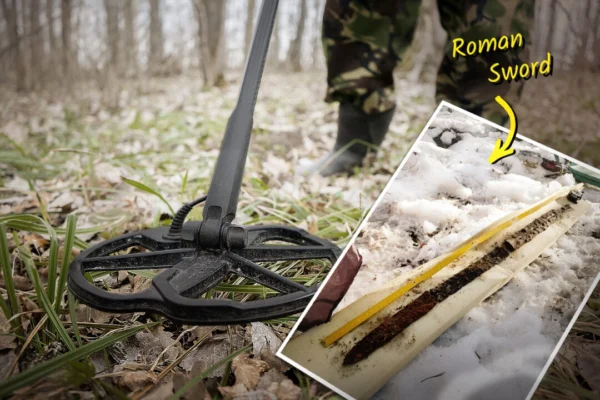On an ordinary yet unusually warm winter day, Rafał Proszows and Mariusz Lampa ventured into the Polish forest near their home with their metal detector, hoping to embark on a new adventure. It is certain that these two friends were there because of their shared passion for World War II history, but neither of them expected to find anything.
Their luck suddenly changed as they stumbled upon a 2,000-year-old broken blade – a fragment of a Roman sword, experts suggest it may be related to some ritual of ancient barbarian culture.
Their original plan was just to scan the forest area near their home in Złoty Potok, a picturesque Polish village located southeast of Częstochowa. They thought they might find a few war trinkets at most. This woodland was the place where the Polish army first engaged with the German army after the German invasion of Poland in 1939, but it also carries even more ancient legends.
“That place is a bit mysterious,” 52-year-old Proszows told Epoch Times when talking about the location where they discovered the sword in January, “There are legends of bandits, buried treasures, and ancient settlements circulating there.”
The weather that day was clear and dry, perfect for metal detecting. Both of them are members of the local Stowarzyszenie Inventum, a metal detecting association that collaborates with museums in excavating and preserving archaeological items.
“That day was supposed to be just a reconnaissance trip – none of us expected any extraordinary discoveries,” said 43-year-old Lampa, “When my metal detector emitted that strong and steady signal, my heart started racing.”
Proszows heard Lampa’s call, and the atmosphere of the reconnaissance mission instantly changed. Proszows said that when they dug up the soil and saw the partially buried object, a surge of adrenaline rushed through him.
“When I saw that fragment of the blade, a wave of humility and responsibility came with it,” Proszows said, “It felt like we were making contact with someone from a distant past, perhaps living 2,000 years ago.”
They unearthed two pieces of what is now identified as a Roman spatha (a short straight-bladed sword for cavalry) from the ground. Experts believe that this sword likely belonged to a member of the Vandals, a Germanic tribe that lived in the Polish region during Roman times.
As members of the Inventum association, the two detectorists were well aware that such an important discovery must be handled according to regulations. After finding the two fragments, they ceased excavation, then secured the site, and contacted the provincial heritage protection officer, the local government, and the Częstochowa museum as required by law.
Museum experts helped extract the third piece of the sword from the site.
“After we cleared the surface and measured the fragments, the total length of the sword reached 98 centimeters,” Lampa said, “It is estimated to weigh between 1.1 and 1.6 kilograms (2.4 to 3.5 pounds) – fitting the lightweight design of spathae made for cavalry use.”
They noticed even the corroded traces on the inner surface of the broken parts, leading researchers to believe that the sword was intentionally broken hundreds of years ago. They also observed hardened areas and enamel-like layers formed by heat, indicating that it had been subjected to fire, possibly related to cremation or some ritual.
“The sword was found broken into three parts, with burn marks, and the area it was in corresponds to a burial or campsite,” Lampa said.
Archaeological interpretations by experts suggested that this may have been a burial offering for a warrior.
“This sword may have been used by a warrior of the Vandal tribe and broken as part of a funeral ritual,” Proszows said, adding that the final conclusion will wait for X-ray and CT scans. The blade is believed to be about 2,000 years old.
On that day, they found more than just the sword, but it was the most prominent discovery. Proszows and Lampa also unearthed several medieval spurs and an axe from the same period.
Despite many metal detecting enthusiasts searching for WWII relics in Poland and elsewhere and keeping their battlefield finds like helmets and shells, Proszows and Lampa stated that they will not keep this Roman sword and related artifacts. They said they would not consider handling them in any other way.
Proszows said he is “absolutely satisfied” that the sword will ultimately end up in a museum. Their discovery will be greatly appreciated and cherished by many.
“This ensures it will be properly preserved, professionally restored, and its history documented and shared with the public,” he said, “Of course, every enthusiast would want to keep such an artifact close, but knowing that the sword is in expert hands and can ‘speak’ its story to the public and researchers gives me immense satisfaction.”
The whole world will also share in the “incredible personal experience” these two detectorists went through.
“Holding the fragments of the sword, I felt a connection with an ancient warrior,” Lampa said, “and that seemingly thousands of years old history suddenly became tangible.”

